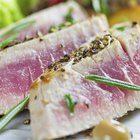Yellowtail tuna is not actually a tuna species, but belongs to the jack fish family. Its appearance resembles that of tuna and is often confused with yellowfin tuna. Most fish contain omega-3 fatty acids, which are a healthy type of fat that supports your health in several ways. Yellowtail contains many additional nutrients, including vitamins A and D, calcium and protein, and is commonly used to prepare sushi.
Omega-3s
Eicosapentaenoic acid, or EPA, and docosahexaenoic acid, or DHA, are both types of omega-3 fatty acids, and both are present in many types of fish, including yellowtail. Omega-3s are essential nutrients because your body cannot produce them; you must get them from your diet. Getting enough omega-3s keeps your brain and heart healthy and aids in healthy growth and development among children. They are also associated with a decreased risk of heart disease, cancer and arthritis. A diet that is lacking in omega-3s can manifest with symptoms that include fatigue, dry skin, depression, circulatory problems and poor memory, according to the University of Maryland Medical Center. The American Heart Association recommends eating fish twice a week to cover your omega-3 fatty acid needs.
Yellowtail
A 100 g serving of raw yellowtail, which equals about 3 1/2 oz., contains 899 mg of EPA and 1,780 mg of DHA. Cooking yellowtail may alter this content slightly, but since it is such a fatty, oily fish, you will benefit from either cooked or raw yellowtail.
Uses
Yellowtail is considered a luxury fish, according to the Sushi Encyclopedia, and is most often served raw. It can be used to make sashimi, which is just thin slices of raw fish, or sushi, which often consists of raw fish and vegetables rolled inside seaweed and sticky rice. Other options include broiling yellowtail fillets with soy sauce or searing it flavored with sesame oil, ginger, lemon, garlic or soy sauce. It can be served alone or on a bed of mixed greens and sliced vegetables. No matter how you choose to prepare it, you will be getting a good dose of omega-3s.
Considerations
Some types of fish aren't safe to eat in large amounts, despite their omega-3 benefits, due to mercury content. Yellowtail tuna is one such fish. Buri, hamachi, inada and kanpachi are other names that refer to yellowtail and all are high in mercury, with more than 0.3 parts per million. Avoid these types of sushi when pregnant and eat in moderation otherwise. Eating raw yellowtail poses the risk of food-borne illnesses, so be sure you are eating it in a reputable location and watch for information regarding any possible outbreaks of pathogens related to eating yellowtail.
Related Articles

Is Grocery Store Fish Safe for Sushi?

How to Cook Ahi Tuna on a Frying Pan

How to Cook Fried Catfish Without It ...

How to Buy Fresh Tuna

Tuna Steaks Nutrition

Can I Eat Sushi Twice a Week?

Substitutes for a Tuna Steak

Is Orange Roughy Safe to Eat?

How to Pan Fry Grouper

How Long Can Tuna Stay Fresh?

How to Cook Shishamo Fish

How to Cook Mackerel in an Oven

Is it Healthier to Cook Salmon With Its ...

Nutrition of Red Snapper Vs. Tilapia

The Benefits of Tuna & Omega-3 Oil

How to Pan-Sear Swordfish

How to Bake Breaded Mahi Mahi

What Are the Health Benefits of Red ...

How to Cook Bluefish

How to Grill a Cod Fish
References
- University of Maryland Medical Center; Omega-3 Fatty Acids; Stephen D. Ehrlich; June 2009
- Sportfish San Diego: Difference Between a Yellowtail and a Yellowfin Tuna
- Sushi Encyclopedia: Yellowtail Sushi
- Tripod: Nutritional Profiles of Some Healthy Fish
- U.S. Food and Drug Administration: Fresh and Frozen Seafood: Selecting and Serving It Safely
Resources
Writer Bio
Eliza Martinez has written for print and online publications. She covers a variety of topics, including parenting, nutrition, mental health, gardening, food and crafts. Martinez holds a master's degree in psychology.